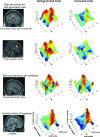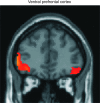The representation of abstract task rules in the human prefrontal cortex
- PMID: 19047573
- PMCID: PMC2705703
- DOI: 10.1093/cercor/bhn222
The representation of abstract task rules in the human prefrontal cortex
Abstract
We have previously reported sustained activation in the ventral prefrontal cortex while participants prepared to perform 1 of 2 tasks as instructed. But there are studies that have reported activation reflecting task rules elsewhere in prefrontal cortex, and this is true in particular when it was left to the participants to decide which rule to obey. The aim of the present experiment was to use functional magnetic resonance imaging (fMRI) to find whether there was activation in common, irrespective of the way that the task rules were established. On each trial, we presented a word after a variable delay, and participants had to decide either whether the word was abstract or concrete or whether it had 2 syllables. The participants either decided before the delay which task they would perform or were instructed by written cues. Comparing the self-generated with the instructed trials, there was early task set activation during the delay in the middle frontal gyrus. On the other hand, a conjunction analysis revealed sustained activation in the ventral prefrontal and polar cortex for both conditions. We argue that the ventral prefrontal cortex is specialized for handling conditional rules regardless of how the task rules were established.
Figures





References
-
- Bunge SA, Kahn I, Wallis JD, Miller EK, Wagner AD. Neural circuits subserving the retrieval and maintenance of abstract rules. J Neurophysiol. 2003;90:3419–3428. - PubMed
-
- Burgess PW, Dumontheil I, Gilbert SJ. The gateway hypothesis of rostral prefrontal cortex (area 10) function. Trends Cogn Sci. 2007;11:290–298. - PubMed
-
- Burgess PW, Veitch E, Costello AL, Shallice T. The cognitive and neuroanatomical correlates of multitasking. Neuropsychologia. 2000;38:848–863. - PubMed
-
- Bussey T, Wise S, Murray E. The role of ventral and orbital prefrontal cortex in conditional visuomotor learning and strategy use in rhesus monkeys (Macaca mulatta) Behav Neurosci. 2001;115:971–982. - PubMed
-
- Devlin JT, Matthews PM, Rushworth MF. Semantic processing in the left inferior prefrontal cortex: a combined functional magnetic resonance imaging and transcranial magnetic stimulation study. J Cogn Neurosci. 2003;15:71–84. - PubMed

